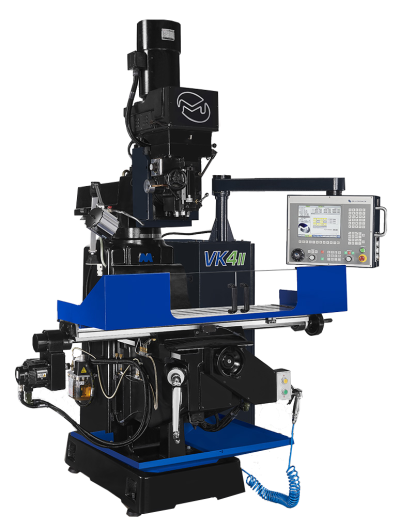
Milltronics USA Inc. introduces the latest generation of its VK series with the new VK4II CNC knee mill. With more than two dozen improvements over the previous version, the VK4II retains the unique Milltronics MillSlide Z-axis. Popular in toolrooms, prototype, R&D and job shops, VK Series machines offer a true 3-axis control and can be run as manual, teach or full CNC. The MillSlide enhances rigidity and allows a programmable Z-axis that can also be operated manually with a quill handle.
Travels are 33” (X) by 15” (Y) by 5.25” MillSlide (Z) with 16.5” (knee) and 5.9” quill (manual). The machine has a 54” x 12” table with 1,500 lbs. capacity. Powered by a 7.5-hp backgeared motor, the VK4II is a 40 taper with a two-speed 3,900-rpm spindle. It’s a flexible machine as the head tilts +/- 90o, offers +/- 11.5” of ram travel, which also swivels +/-90o. Standard handwheels are directly coupled to the ballcrews and provide feedback to the operator. Options include flood coolant and drip pan, table guard, power knee and power draw bar.
Featuring the Milltronics Series 8200-B CNC, the VK4II can be programmed with easy conversational, G code or a CAM system. The 8200B is a PC-based control with advanced processing speeds and 1 GM memory, 2 GB disk storage, a 12” LCD monitor and membrane keys. It has easy navigation function keys, solid model graphics, 3D pocket, DXF import, pockets & islands, tool tables, help screens, mid-program restart, handwheel run, scaling, mirror image, rotate and a variety of canned cycles, such as drilling, boring, tapping and milling .
According to Louie Pavlakos, Milltronics USA general manager, “We’re excited about the new VK4II as its a machine our customers have been asking for. In today’s machine tool market, there are lots and lots of very sophisticated multi-axis machines available that are sometimes overkill depending on the job.”
Milltronics has installed more than 1,500 VK Series machines worldwide over the years and the new VK4II features more than two dozen improvements over the previous generation. “Our customers say they still want and need flexible easy-to-use CNC knee mills,” Pavlakos said. “It’s about selecting the right machine for the job. The VK4II offers the latest technology in a knee mill for about the same price as the previous version.”
Contact Details
Related Glossary Terms
- boring
boring
Enlarging a hole that already has been drilled or cored. Generally, it is an operation of truing the previously drilled hole with a single-point, lathe-type tool. Boring is essentially internal turning, in that usually a single-point cutting tool forms the internal shape. Some tools are available with two cutting edges to balance cutting forces.
- computer numerical control ( CNC)
computer numerical control ( CNC)
Microprocessor-based controller dedicated to a machine tool that permits the creation or modification of parts. Programmed numerical control activates the machine’s servos and spindle drives and controls the various machining operations. See DNC, direct numerical control; NC, numerical control.
- computer-aided manufacturing ( CAM)
computer-aided manufacturing ( CAM)
Use of computers to control machining and manufacturing processes.
- coolant
coolant
Fluid that reduces temperature buildup at the tool/workpiece interface during machining. Normally takes the form of a liquid such as soluble or chemical mixtures (semisynthetic, synthetic) but can be pressurized air or other gas. Because of water’s ability to absorb great quantities of heat, it is widely used as a coolant and vehicle for various cutting compounds, with the water-to-compound ratio varying with the machining task. See cutting fluid; semisynthetic cutting fluid; soluble-oil cutting fluid; synthetic cutting fluid.
- gang cutting ( milling)
gang cutting ( milling)
Machining with several cutters mounted on a single arbor, generally for simultaneous cutting.
- milling
milling
Machining operation in which metal or other material is removed by applying power to a rotating cutter. In vertical milling, the cutting tool is mounted vertically on the spindle. In horizontal milling, the cutting tool is mounted horizontally, either directly on the spindle or on an arbor. Horizontal milling is further broken down into conventional milling, where the cutter rotates opposite the direction of feed, or “up” into the workpiece; and climb milling, where the cutter rotates in the direction of feed, or “down” into the workpiece. Milling operations include plane or surface milling, endmilling, facemilling, angle milling, form milling and profiling.
- milling machine ( mill)
milling machine ( mill)
Runs endmills and arbor-mounted milling cutters. Features include a head with a spindle that drives the cutters; a column, knee and table that provide motion in the three Cartesian axes; and a base that supports the components and houses the cutting-fluid pump and reservoir. The work is mounted on the table and fed into the rotating cutter or endmill to accomplish the milling steps; vertical milling machines also feed endmills into the work by means of a spindle-mounted quill. Models range from small manual machines to big bed-type and duplex mills. All take one of three basic forms: vertical, horizontal or convertible horizontal/vertical. Vertical machines may be knee-type (the table is mounted on a knee that can be elevated) or bed-type (the table is securely supported and only moves horizontally). In general, horizontal machines are bigger and more powerful, while vertical machines are lighter but more versatile and easier to set up and operate.
- solid model
solid model
3-D model created using “building blocks.” This is the most accurate way of representing real-world objects in CAD.
- tapping
tapping
Machining operation in which a tap, with teeth on its periphery, cuts internal threads in a predrilled hole having a smaller diameter than the tap diameter. Threads are formed by a combined rotary and axial-relative motion between tap and workpiece. See tap.
